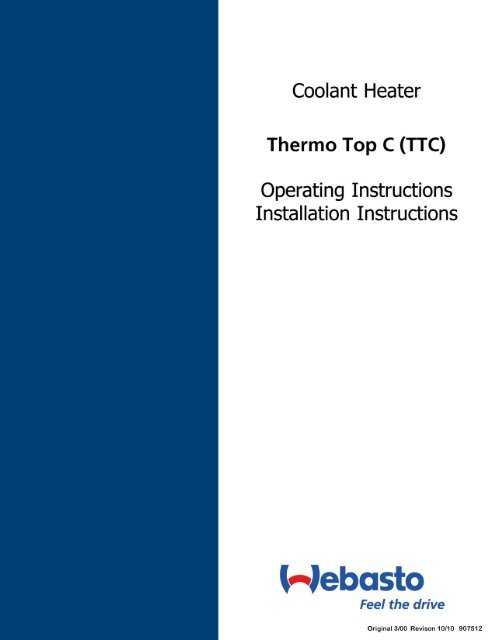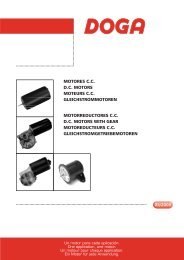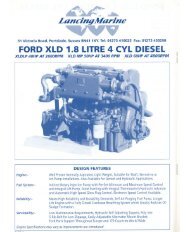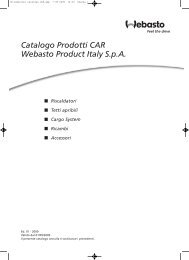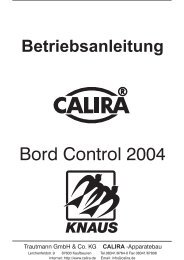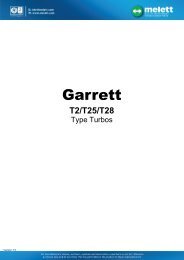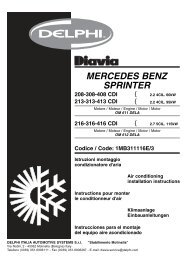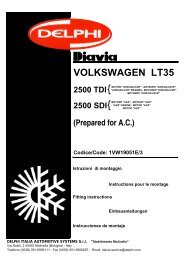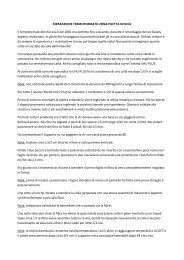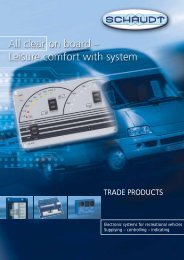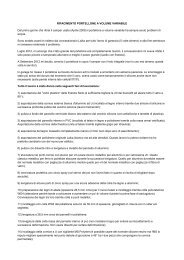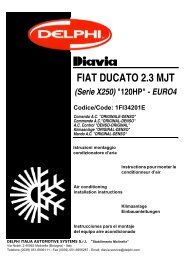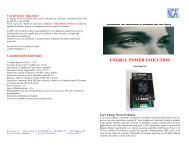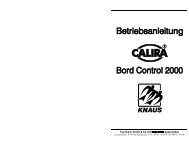Thermo Top C - Giordano Benicchi
Thermo Top C - Giordano Benicchi
Thermo Top C - Giordano Benicchi
Create successful ePaper yourself
Turn your PDF publications into a flip-book with our unique Google optimized e-Paper software.
<strong>Thermo</strong> <strong>Top</strong> C Installation / Operation Manual<br />
Contents<br />
Contents<br />
1. Introduction<br />
1.1 General Description ........................................................................................................ 101<br />
1.2 Legal Provisions ............................................................................................................. 102<br />
1.3 Meaning of Warning, Caution and Note.......................................................................... 102<br />
2. Operating the Webasto <strong>Thermo</strong> <strong>Top</strong> C (TTC)<br />
2.1 Switching On................................................................................................................... 201<br />
2.2 Switching Off................................................................................................................... 202<br />
2.3 Operation with Optional Digital Timer ............................................................................. 202<br />
2.4 Digital Timer Setting / Operating Instructions ................................................................. 204<br />
3. Technical Data<br />
3.1 Technical Data................................................................................................................ 301<br />
3.2 Heater Dimensions ......................................................................................................... 302<br />
3.3 Fuel Pump Dimensions................................................................................................... 302<br />
4. Installation<br />
4.1 General Information ........................................................................................................ 401<br />
4.2 Installation Locations ...................................................................................................... 401<br />
4.3 Mounting the Heater ....................................................................................................... 402<br />
4.4 Exhaust Pipe Connection ............................................................................................... 403<br />
4.5 Combustion Air Supply ................................................................................................... 403<br />
4.6 Plumbing the System...................................................................................................... 404<br />
4.6.1 General Information ............................................................................................. 404<br />
4.6.2 Plumbing the <strong>Thermo</strong> <strong>Top</strong> C into The Coolant System........................................ 405<br />
4.6.3 Contents - Engine Connections ........................................................................... 407<br />
4.7 Fuel System.................................................................................................................... 415<br />
4.7.1 General Description ............................................................................................. 415<br />
4.7.2 Fuel System Limitations ....................................................................................... 415<br />
4.7.3 Fuel Pump............................................................................................................ 416<br />
4.7.4 Fuel Standpipe ..................................................................................................... 416<br />
4.7.5 Fuel Line .............................................................................................................. 418<br />
4.7.6 Fuel Filter ............................................................................................................. 418<br />
4.8 Wiring Connections......................................................................................................... 419<br />
4.8.1 General Information ............................................................................................. 419<br />
4.8.2 Power Connection to Battery ............................................................................... 419<br />
4.8.3 Switch and Timer Connections ............................................................................ 419<br />
4.8.4 Wiring Diagram - <strong>Thermo</strong> <strong>Top</strong> C (12 Volt) with On/Off Toggle Switch................. 421<br />
4.8.5 Wiring Diagram - <strong>Thermo</strong> <strong>Top</strong> C (12 Volt) with Optional Digital Timer ................ 422<br />
4.9 Initial Operation............................................................................................................... 423<br />
5. Maintenance of the Heater<br />
5.1 Annual Maintenance ....................................................................................................... 501<br />
I
Contents<br />
<strong>Thermo</strong> <strong>Top</strong> C Installation / Operation Manual<br />
Contents<br />
6. Basic Troubleshooting<br />
6.1 General Information ........................................................................................................ 601<br />
6.2 General Failure Symptoms ............................................................................................. 601<br />
6.3 Heater Lockout Reset Procedure ................................................................................... 602<br />
6.4 PC Diagnostics Kit .......................................................................................................... 602<br />
List of Figures<br />
101 Webasto <strong>Thermo</strong> <strong>Top</strong> C Coolant Heater........................................................................ 101<br />
201 Optional 7-Day Timer...................................................................................................... 203<br />
301 Heater Dimensions ......................................................................................................... 302<br />
302 Fuel Pump Dimensions................................................................................................... 302<br />
401 Installation Locations ...................................................................................................... 401<br />
402 Permissible Heater Installation Positions........................................................................ 402<br />
403 Engine Block Preheating and/or Boost Heating.............................................................. 405<br />
404 Fuel System Limitations.................................................................................................. 415<br />
405 Fuel Pump Mounting (DP 30) ......................................................................................... 416<br />
406 Fuel Standpipe................................................................................................................ 417<br />
407 Fuel Line Connection...................................................................................................... 418<br />
408 On/Off Toggle Switch...................................................................................................... 420<br />
409 Optional 7-Day Digital Timer........................................................................................... 420<br />
410 Wiring Diagram - <strong>Thermo</strong> <strong>Top</strong> C with On/Off Toggle Switch.......................................... 421<br />
411 Wiring Diagram - <strong>Thermo</strong> <strong>Top</strong> C with Optional Digital Timer ......................................... 422<br />
List of Tables<br />
201 Digital Timer Setting Instructions .................................................................................... 204<br />
301 Technical Data - Heater ................................................................................................. 301<br />
302 Technical Data - Circulating Pump ................................................................................ 301<br />
601 General Failure Symptoms ............................................................................................. 601<br />
Item No. 907512<br />
Org. 9/1/99 Subject to modification.<br />
II
<strong>Thermo</strong> <strong>Top</strong> C (TTC) 1 Introduction<br />
1. Introduction<br />
1.1 General Description<br />
Fig. 101:<br />
Webasto <strong>Thermo</strong> <strong>Top</strong> C Coolant Heater<br />
1. Control Unit. 6. Coolant Outlet Connection Pipe<br />
2. Combustion Air Fan Assembly 7. Fuel Inlet Connection Pipe<br />
3. Combustion Air Inlet Connection Pipe 8. Exhaust Outlet Pipe<br />
4. Coolant Circulating Pump 9. Combustion Chamber<br />
5. Coolant Inlet Connection Pipe 10. Heat Exchanger<br />
The Webasto TTC is designed for Class 3-7 vehicles. This dynamic system allows you to<br />
preheat engines on or offsite. The TTC offers high performance with low power and fuel<br />
consumption. Approximately 2-hours of operation eliminates overnight idling for heating and the<br />
need for expensive electrical plug-ins. The compact design allows the heater to be frame rail or<br />
engine compartment mounted. The TTC is easy to install, maintain and operate. The universal<br />
package fits most of today vehicles.<br />
101
1 Introduction <strong>Thermo</strong> <strong>Top</strong> C (TTC)<br />
1.2 Legal provisions<br />
Heater installation must be performed in accordance with the manufacturer`s installation<br />
instructions.<br />
Any deviation from these instructions are only permitted with the written approval from Webasto<br />
<strong>Thermo</strong>systems Inc.<br />
It is the dealer responsibility to approve installations not performed by Webasto trained<br />
personnel.<br />
Installation not complying with the installation instructions release Webasto <strong>Thermo</strong>systems Inc.<br />
from any product liability.<br />
OEM installations must be approved by Webasto <strong>Thermo</strong>systems Inc.<br />
1.3 Meaning of Warning, Caution and Note<br />
WARNING!<br />
This heading is used to highlight that noncompliance with instructions or procedures may cause<br />
injuries or lethal accidents to personnel.<br />
CAUTION!<br />
This heading is used to highlight that noncompliance with instructions or procedures may cause<br />
damage to equipment.<br />
NOTE:<br />
This heading is used to highlight and draw specific attention to information.<br />
102
<strong>Thermo</strong> <strong>Top</strong> C (TTC) 2 Operating the Webasto<br />
2. Operating the Webasto <strong>Thermo</strong> <strong>Top</strong> C (TTC)<br />
Before switching on theTTC, set vehicle heating system to the fiheat position and open any shut<br />
off valves. Depending on the type of control installed in the dashboard of the vehicle, the TTC can<br />
be operated by the following methods.<br />
2.1 Switching On<br />
Using a Switch:<br />
Using the Optional Digital Timer:<br />
Using the Switch:<br />
When the switch is used for turning ON the TTC, the operation indicator (toggle) lights up.<br />
Shortly thereafter, the heater begins operation and delivers heated coolant to the engine.<br />
Using the Optional 7-Day Digital Timer:<br />
1. Set the timer up to 2 hr. before you want to start the engine. The heater will start up at set time.<br />
(See timer operating instructions.)<br />
Or switch fiinstan onf switch on your timer in the vehicle dash to ON The heater will start up.<br />
2. When time is elapsed on your timer or engine preheat is no longer required, switch the TTC<br />
heater OFF The TTC will go through the after-run cycle.<br />
Pushing the fiinstan heatf button or when timer setting reaches desired start time, the fioperatio<br />
indicatorf on the timer will light, signaling that the heater is in operation.<br />
See section 2.3 fiOperatio with 7-Day Digital Timerf for complete instructions.<br />
NOTE:<br />
If heater is being switched on while the engine is warm only the circulating pump will run, coolant<br />
temperature must fall below 86 °F. (30 °C.) before heater starts.<br />
Startup Sequence:<br />
The coolant circulating pump, ceramic igniter and combustion air fan start operation and after<br />
approximately 60 seconds combustion starts (audible combustion sound).<br />
After the coolant temperature has reached the set point of 170 °F (77 °C) the TTC will<br />
automatically adjust its heat output to a lower operating range (part-load heat output).<br />
If the temperature of the coolant continues to rise and climb over 174 °F (79 °C) at the heater outlet,<br />
the heater will cycle off.<br />
When the temperature falls below 149 °F (65 °C) the heater will restart and repeat the heating cycle.<br />
201
2 Operating the Heater <strong>Thermo</strong> <strong>Top</strong> C (TTC)<br />
WARNING!<br />
Due to the danger of poisoning and asphyxiation the heater must not be operated in enclosed<br />
spaces such as garages or workshops without adequate exhaust extraction or ventilation.<br />
The <strong>Thermo</strong> <strong>Top</strong> C (TTC) will cycle on and off until:<br />
1. The toggle switch is switched OFF<br />
2. The fiinstan heatf button is pressed once again, signaling heater to shut off.<br />
3. Time has elapsed on the timer.<br />
4. The vehicle battery voltage drops below 9.6 V or the TTC runs out of fuel.<br />
WARNING!<br />
Explosion hazard! The heater must be switched fiOFF while refueling and at fueling stations.<br />
WARNING!<br />
Explosion hazard! Do not operate any Webasto heater in an area where toxic or explosive<br />
materials or fumes may be present.<br />
2.2 Switching Off<br />
Manually: When heating is no longer required, switch the TTC heater off by means of the toggle<br />
switch or by pressing the fiinstan heatf button on the optional timer.<br />
The indicator light turns off, combustion is extinguished followed by an after run cycle of<br />
approximately 90 seconds.<br />
Automatically: When the optional timer has reached the end of the timed cycle (up to 2 hours).<br />
NOTE:<br />
Restarting the heater during the after-run period is permitted.<br />
2.3 Operation with Optional 7-Day Digital Timer<br />
The timer enables you to preset the start time of the heater up to 7 days in advance.<br />
In addition, the timer enables the heater to be switched on and off instantly thereby eliminating the<br />
need for a separate switch.<br />
When the heater is in operation, the display and operation buttons of the timer are illuminated.<br />
The timer features a wake up alarm function.<br />
Programmed Heater Operation<br />
Three memory locations numbered 1 to 3 are available. Each memory location can be assigned a<br />
given time together with the day of the week of which only one can be activated at any one time.<br />
202
<strong>Thermo</strong> <strong>Top</strong> C (TTC) 2 Operating the Heater<br />
Preselected Starting Times<br />
The preselected starting time is the time at which the timer switches the heater on automatically.<br />
We recommend that memory locations 1 and 2 be used for presetting starting times within 24 hours<br />
of setting the timer.<br />
Memory location 3 can be used for a starting time within the next 7 days of setting the timer.<br />
Operating Time<br />
The period of time during which the heater is in operation is referred to as operating time.<br />
The heater remains in operation for as long as the operating time has been preset.<br />
Heater operation can be preselected for any time from as little as 1 minute to a maximum of<br />
120 minutes (factory preset is 60 minutes).<br />
Remaining Operating Time<br />
The remaining operating time refers to the period of time the heater still continues to remain in<br />
operation. It can only be changed while heater is in operation.<br />
Setting the Digital Timer<br />
After the power has been connected, all symbols on the digital display will be flashing.<br />
The time of the day and the day of the week must be set.<br />
The Timer can be programmed in that all flashing symbols can be adjusted by means of the<br />
and buttons.<br />
If the buttons are not pressed within 5 seconds, the currently displayed time or function will be<br />
stored.<br />
When the and buttons are pressed for more than 2 seconds, the quick digit advance mode<br />
is activated.<br />
See table 201 on following page for setting reference or full instructions supplied with timer.<br />
Fig. 201:<br />
Optional 7-Day Digital Timer<br />
203
2 Operating the Heater <strong>Thermo</strong> <strong>Top</strong> C (TTC)<br />
2.4 Digital Timer Setting / Operating Instructions<br />
Switching the heater<br />
on<br />
Switching the heater<br />
off<br />
Setting time / day of<br />
the week<br />
Manually: by pressing the button (continuous heating mode)<br />
Automatically: by programming the heater starting time<br />
Manually: by pressing the button<br />
Automatically: after the programmed operating time has elapsed.<br />
With the heater running: by programming the remaining operating time.<br />
Press the button for more than 2 seconds - time of the day is flashing - and set the clock<br />
using the and buttons. After 10 seconds, day of the week begins flashing - set the day of<br />
the week in the same manner as the time.<br />
Viewing the time With the ignition switched off: press the button (bus wiring only).<br />
Programming heater<br />
starting time<br />
Press the button - the memory location is flashing - using the and buttons set start of<br />
the heater operating time. After 10 seconds, day of the week begins flashing - set the day of<br />
the week on which the heater is to turn on.<br />
By repeatedly pressing the button, memory locations 2 and 3 can be programmed or the time<br />
display mode can be reached.<br />
Recalling / erasing<br />
preset times<br />
Repeatedly press the<br />
preset time, press the<br />
memory location.<br />
button until the desired memory location is displayed. To erase the<br />
button several times until the time of the day is displayed instead of the<br />
Programming<br />
duration of operating<br />
time<br />
Setting the<br />
remaining operating<br />
time (Bus wiring<br />
Option)<br />
Setting the wake up<br />
time<br />
( Digital Comfort<br />
Timer Only)<br />
Recalling / erasing<br />
the wake up time<br />
Remote control<br />
The heater must be switched off. Press the button for 3 seconds - operating time is flashing -<br />
and set the desired operating time (10 to 120 minutes) using the and buttons.<br />
Set the desired remaining operating time (1 to 120 minutes) using the and buttons. The<br />
remaining operating time refers to the time the heater still continues to remain in operation after<br />
the vehicle ignition is turned off. It can only be changed while the heater is in operation and the<br />
ignition switched off.<br />
A wake up time can only be programmed on the fi1531 comfort digital timer. The wake up time<br />
is not bound to a specific day of the week. Repeatedly press the button until the bell symbol<br />
appears on the display. Set the desired wake up time using the and buttons. The<br />
alarm clock turns off after 5 minutes or when one of the buttons is pressed.<br />
To recall the wake up time, repeatedly press the button until bell symbol appears on the<br />
display - read off wake up time. To erase the wake up time: press the button until the bell<br />
symbol is no longer visible on the display.<br />
Possible by means of an optional external signal.<br />
Table 201:<br />
Digital Timer Setting Instructions<br />
204
<strong>Thermo</strong> <strong>Top</strong> C (TTC) 3 Technical Data<br />
3. Technical Data<br />
3.1 Technical Data<br />
The following data is subject to the normal tolerance for heaters, if no tolerance is specified.<br />
This is approximately +/-10% in an ambient of 20 °C at nominal voltage.<br />
Heater<br />
<strong>Thermo</strong> <strong>Top</strong> C (TTC) Diesel<br />
Design<br />
Coolant heater with evaporator burner (Ferro-Tech Technology)<br />
Heat Rating:<br />
Input<br />
Output<br />
Fuel<br />
Fuel Consumption:<br />
- full load<br />
- partial load<br />
- full load<br />
- partial load<br />
- full load<br />
- partial load<br />
Rated Voltage<br />
Operating Voltage<br />
Rated Power Consumption Including<br />
Circulating Pump:<br />
- full load<br />
- partial load<br />
Maximum Permissible Ambient<br />
Temperature:<br />
Heater:<br />
- operation<br />
- storage<br />
Fuel Pump<br />
- operation<br />
Maximum Allowable Working Pressure<br />
(Coolant System)<br />
Capacity of Heat Exchanger<br />
Minimum Capacity of Coolant System<br />
Minimum Volume of Flow<br />
CO2 Content in Exhaust Gas<br />
Dimensions of Heater<br />
Weight<br />
Table 301:<br />
Technical Data - Heater<br />
6.14 kW (20,960 Btu/hr)<br />
3.1 kW (10,480 Btu/hr)<br />
5.0 kW (17,200 Btu/hr)<br />
2.5 kW (8,600 Btu/hr)<br />
Diesel #1 Diesel #2 and Arctic<br />
0.61 l/hr (0.16 US gal/hr)<br />
0.30 l/hr (0.08 US gal/hr)<br />
12 Volts<br />
9.6... 15 Volts<br />
46 Watts (3.8 Amps)<br />
32 Watts (2.6 Amps)<br />
- 40... +60 °C (- 40...+140 °F)<br />
- 40... +120 °C (- 40...+248 °F)<br />
- 40... +20 °C (- 40...+68 °F)<br />
0.4... 2.5 bar (6.0... 36 psi)<br />
0.15 Liters (.04 US gal)<br />
4.0 Liters (1 US gal)<br />
250 l/hr (66 US gal/hr)<br />
8... 12.0 Vol.-%<br />
Length 232 mm (9.1 in)<br />
Width 105 mm (4.1 in)<br />
Height 163 mm (6.4 in)<br />
3.2 kg (7.0 lbs.)<br />
Circulating Pump Model U 4847<br />
Volume Flow Against 0.13 bar (1.9 lbs.)<br />
450 l/hr (2.0 US gal/min)<br />
Rated Voltage<br />
12 Volts<br />
Operating Voltage Range<br />
9.6... 15 Volts<br />
Rated Power Consumption<br />
14 Watts (1.16 Amps)<br />
Dimensions of Circulating Pump<br />
L 95 mm xW61mmxH61mm(3.7f x 2.4f x 2.4fl<br />
Weight<br />
0.3 kg (.66 lbs)<br />
Table 302: Technical Data - Circulating Pump<br />
301
3 Technical Data <strong>Thermo</strong> <strong>Top</strong> C (TTC)<br />
3.2 Heater Dimensions<br />
Fig. 301:<br />
Heater Dimensions<br />
Fig. 302:<br />
Fuel Pump Dimensions<br />
302
<strong>Thermo</strong> <strong>Top</strong> C (TTC) 4 Installation<br />
4. Installation<br />
4.1 General Information<br />
Webasto will take you step by step through the installation process to ensure successful operation<br />
for years to come. The installation must be performed in accordance with the installation instructions<br />
provided in this manual.<br />
WARNING!<br />
Asphyxiation risk! The heater must not be installed in either the driverscompartment or in the<br />
passenger area of the vehicle.<br />
NOTE:<br />
This manual does not cover all possible installations. For special applications use this manual as a<br />
general guideline only. Contact an authorized Webasto dealer or Webasto <strong>Thermo</strong>systems directly<br />
at USA: 1-800-555-4518 Canada: 1-800-667-8900<br />
4.2 Installation Locations<br />
Fig. 401:<br />
Installation Locations<br />
1. Inside of the engine compartment in a splash protected area (Preferred).<br />
2. On left/right side of the frame.<br />
3. Inside under-step compartment.<br />
401
4 Installation <strong>Thermo</strong> <strong>Top</strong> C (TTC)<br />
4.3 Mounting the Heater<br />
Fig. 402:<br />
Permissible Heater Installation Positions<br />
WARNING!<br />
Asphyxiation risk! DO NOT mount heater inside passenger, sleeper or storage areas.<br />
CAUTION!<br />
The openings of the water connecting pipes must never point in a downward direction in any<br />
installation position. Damage to heater will result due to trapped air in heat exchanger.<br />
CAUTION!<br />
The heater must not be installed in the immediate vicinity of or above hot vehicle parts.<br />
The heater must not be installed in the direct splash water area of the wheels.<br />
The heater should be mounted as low as possible in the vehicle to assure automatic purging of air<br />
from circulating pump and coolant lines. The coolant pump is not self-priming.<br />
Preferably, the heater should be mounted in the engine compartment.<br />
1. Ensure adequate clearance for heater and components in existing enclosure or mounting area.<br />
2. Carefully layout proposed heater mounting position and mark all holes for drilling keeping in<br />
mind location for exhaust, coolant lines and wiring access. Once all requirements are met,<br />
drill holes.<br />
3. Mount heater and components according to your plan, fasteners for mounting heater are<br />
provided.<br />
NOTE:<br />
Heavy Duty frame rail bracket is available. Order under part number 901088.<br />
402
<strong>Thermo</strong> <strong>Top</strong> C (TTC) 4 Installation<br />
4.4 Exhaust Pipe Connection<br />
WARNING!<br />
Asphyxiation risk! Exhaust pipes must be so routed that the possibility of exhaust fumes entering<br />
the vehicle is unlikely.<br />
CAUTION!<br />
Route the exhaust pipe in such a way as to prevent touching or being directed toward any part of<br />
the vehicle that may be damaged by heat (i.e., brake lines, electrical wiring, hoses).<br />
NOTE:<br />
Additional flexible exhaust tubing is available from your Webasto Distributor or Dealer under part<br />
number 900126.<br />
One meter (39 inches) of flexible exhaust tubing has been supplied with the heater. Attach tube to<br />
the heater with exhaust clamp supplied.<br />
The exhaust tube should be routed in a gradual downward slope away from heater allowing<br />
condensation to drain.<br />
Secure exhaust tube to vehicle with fiP clip supplied. Keep exhaust tube at least 2 in. (50 mm) away<br />
from heat sensitive materials.<br />
The outlet opening of the exhaust tube must not point in the direction of travel to avoid any possible<br />
clogging caused by snow, mud or foreign materials.<br />
4.5 Combustion Air Supply<br />
WARNING!<br />
Never draw combustion air from inside the vehicle, or from areas where fumes or gases can<br />
accumulate. Drawing of combustion air from areas where people are present is strictly prohibited!<br />
A combustion air tube has been supplied with the heater. Looking at the tube, you will see one end<br />
has a staple holding the inner liner and outer casing together.<br />
The stapled end is the inlet end of the tube, the other end is to be attached to the heater.<br />
To attach tube to the heater, stretch the outer casing about an inch further than the inner liner.<br />
This will then slip over the inlet pipe of the heater and clamped in place.<br />
Do not make any bends immediately after the attachment point to the heater. Doing so may cause a<br />
restriction where the inner liner of the tube begins. Make all bends at least 3 inches away or further<br />
from heater connection point.<br />
The combustion air tube should be routed in a gradual downward slope away from heater allowing<br />
moisture to drain.<br />
The intake opening of the combustion air tube must not point in the direction of travel to avoid any<br />
possible clogging caused by snow, mud or foreign materials.<br />
Combustion air should always be taken from a clean area protected from road splash.<br />
403
4 Installation <strong>Thermo</strong> <strong>Top</strong> C (TTC)<br />
4.6 Plumbing the System<br />
4.6.1 General Information<br />
The TTC with coolant circulating pump must be mounted at least 6" (15 cm) below the lowest<br />
permissible coolant level of the vehicles cooling system.<br />
Minimum amount of coolant in the cooling system should be at least 1.0 US gal. (4.0 l). Independent<br />
heating systems require a minimum of 3.0 US gal. (12.0 l). A minimum of 10% of a good quality<br />
antifreeze should be maintained in the cooling system at all times.<br />
Heater and water pump fit 3/4f (19 mm) I.D. heater hose meeting SAE 20 R3 specifications.<br />
Silicone hose requires special hose clamps.<br />
WARNING!<br />
Burn risk! When working on the coolant system, allow the engine to cool down and open the<br />
radiator cap<br />
NOTE:<br />
Heater hose must meet SAE 20 R3 specifications.<br />
NOTE:<br />
Hose clamps must be tightened to 45 in/LB. (5 Nm) torque. Silicone hose requires special hose<br />
clamps.<br />
404
<strong>Thermo</strong> <strong>Top</strong> C (TTC) 4 Installation<br />
4.6.2 Plumbing the TTC into The Coolant System<br />
Fig. 403:<br />
Engine Block Preheating<br />
Engine Block Preheating:<br />
1. Remove radiator pressure cap and release system pressure.<br />
2. Drain coolant from engine.<br />
3. Plumb the Webasto system as shown above.<br />
4. Refill engine coolant as per engine manufacturersrecommendations and reinstall the radiator<br />
pressure cap.<br />
405
4 Installation <strong>Thermo</strong> <strong>Top</strong> C (TTC)<br />
406
<strong>Thermo</strong> <strong>Top</strong> C (TTC 4<br />
4.6.3 Contents - Engine Connections<br />
Caterpillar<br />
3116 ............................................................................................................................. 408<br />
3176 ............................................................................................................................. 408<br />
3306 ............................................................................................................................. 409<br />
3408 ............................................................................................................................. 409<br />
C-10/C-12 ....................................................................................................................... 410<br />
Cummins<br />
B Series .......................................................................................................................... 411<br />
C Series .......................................................................................................................... 412<br />
Detroit Diesel<br />
Series 50......................................................................................................................... 413<br />
Series 55......................................................................................................................... 413<br />
Mack<br />
E6 / E7 ............................................................................................................................ 414<br />
407
4<br />
<strong>Thermo</strong> <strong>Top</strong> C(TTC)<br />
Caterpillar<br />
Caterpillar 3116<br />
Caterpillar 3176<br />
408
<strong>Thermo</strong> <strong>Top</strong> C (T<br />
Caterpillar<br />
Caterpillar 3306<br />
Caterpillar 3408<br />
409
4 <strong>Thermo</strong> <strong>Top</strong> C (TTC)<br />
Caterpillar<br />
Caterpillar C-10, C-12<br />
410
<strong>Thermo</strong> <strong>Top</strong> C (TTC)4<br />
Cummins<br />
Cummins B Series<br />
411
4 <strong>Thermo</strong> <strong>Top</strong> C (TTC)<br />
Cummins<br />
Cummins C Series<br />
412
<strong>Thermo</strong> <strong>Top</strong> C (TTC)<br />
4<br />
Detroit Diesel<br />
Detroit Diesel Series 50<br />
Detroit Diesel Series 55<br />
413
4 <br />
<strong>Thermo</strong> <strong>Top</strong> C (TTC)<br />
Mack<br />
Mack E6 / E7<br />
414
<strong>Thermo</strong> <strong>Top</strong> C (TTC) 4 Installation<br />
4. Installation<br />
4.7 Fuel System<br />
4.7.1 General Description<br />
The pump, fuel line and fuel standpipe are integral to the systems reliability and must be installed<br />
according to these instructions to ensure proper heater operation.<br />
4.7.2 Fuel System Limitations<br />
CAUTION!<br />
If the fuel tank is higher than the fuel pump, the top of the tank may not be more than 20" above the<br />
pump.<br />
Fig. 404:<br />
Fuel System Limitations<br />
Maximum suction height (A) = 33"(1m)<br />
Maximum suction length (A + B) = 66"(2m)<br />
Maximum delivery length (C + D) = 196"(6m)<br />
Maximum delivery height (D) = 99"(3m)<br />
415
4 Installation <strong>Thermo</strong> <strong>Top</strong> C (TTC)<br />
4.7.3 Fuel Pump<br />
The fuel pump MUST be mounted in a horizontal position in order to function correctly and deliver<br />
the proper quantity of fuel.<br />
Mount the fuel pump as close to the fuel source as practicable.<br />
Do not mount fuel pump near heat sources (exhaust pipes, hot coolant lines, etc.)<br />
Pay particular attention to the fuel line and pump limitations as covered in sections 4.7.2. and 4.7.3.<br />
Fig. 405: Fuel Pump Mounting (DP 30)<br />
4.7.4 Fuel Standpipe<br />
The fuel is drawn from the vehicles fuel tank through a fuel standpipe. This standpipe can be utilized<br />
on vehicles with a spare threaded port, or if no threaded port is available, a 1" hole can be drilled into<br />
the tank and the universal tank boss installed as shown in figure 407. Keep the fuel standpipe 2"<br />
from the bottom of fuel tank.<br />
Fuel standpipe installation:<br />
1. Cut or extend fuel standpipe to length, approx. 2" off fuel tank bottom. Angle the cut to prevent<br />
clogging. Remove burrs from cut end.<br />
2. Install the universal fuel standpipe<br />
- use 1/4" or 1/2" spare port on fuel tank (if available) and install fuel standpipe<br />
or<br />
- drill 1" hole on top of tank (assemble tank-boss and fuel standpipe) and install assembled<br />
universal fuel standpipe<br />
3. Connect fuel line from fuel metering pump to fuel standpipe using rubber connectors and clamps.<br />
4. Route and secure fuel line from heater to fuel tank.<br />
NOTE:<br />
Fuel standpipe with universal tank boss can be installed from outside of tank. First assemble fuel<br />
standpipe and tank-boss and then insert at an angle through the 1f hole previously drilled into tank.<br />
Tighten down with nut provided. Do not over-tighten.<br />
416
<strong>Thermo</strong> <strong>Top</strong> C (TTC) 4 Installation<br />
Fuel Standpipe<br />
Fig. 406:<br />
Fuel Standpipe<br />
417
4 Installation <strong>Thermo</strong> <strong>Top</strong> C (TTC)<br />
4.7.5 Fuel Line<br />
Fuel line, couplers and clamps are provided in the installation kit and are required for proper<br />
operation.<br />
CAUTION!<br />
Fuel line must be secured every 12f (30 cm) and kept away from hot exhaust and moving parts<br />
(drive shaft, wheels, etc.<br />
NOTE:<br />
Use supplied hose clamps to secure all fuel line connections.<br />
The TTC has been equipped with fuel line meeting the required specifications for proper<br />
operation.<br />
The inside diameter of this fuel line is 0.08f (2.0 mm) and must not be substituted for fuel line of a<br />
larger diameter. Doing so will result in improper fuel delivery and the formation of air pockets in the<br />
fuel system which will interfere with heater operation.<br />
Fuel line connections must be made as shown in figure 407, fuel line connection.<br />
Fig. 407:<br />
Fuel Line Connection<br />
4.7.6 Fuel Filter<br />
The TTC heater may be equipped with a fuel filter.<br />
Fuel filters require changing at least annually and in cases of dirty fuel more often.<br />
NOTE:<br />
If heater is equipped with a fuel filter, change filter at least annually.<br />
418
<strong>Thermo</strong> <strong>Top</strong> C (TTC) 4 Installation<br />
4.8 Wiring Connections<br />
4.8.1 General Information<br />
The control unit is equipped with low voltage protection, therefore it is imperative to keep the<br />
vehiclesbattery connections and battery in good condition.<br />
NOTE:<br />
The Webasto heating system will not perform to your satisfaction with a weak battery.<br />
4.8.2 Power Connection to Battery<br />
Power harness connection instructions:<br />
1. Route and secure wire harness from Webasto heater to battery box and cut harness to length.<br />
2. Strip wires and crimp supplied ring tongue terminals to the positive (red) and negative (brown)<br />
wire leads.<br />
3. Clean any corrosion from battery terminals.<br />
4. Connect the leads to the battery terminals.<br />
5. Protect connections with an anticorrosion compound designed for use with electrical connections<br />
and battery terminals.<br />
CAUTION!<br />
If welding is to be performed on the vehicle, the main battery cables must be disconnected from the<br />
battery to protect the electronic control unit.<br />
4.8.3 Switch and Timer Connections<br />
CAUTION!<br />
When drilling holes on the vehicle, do not drill into existing wiring or other mechanical components.<br />
Switch Installation:<br />
1. Select a suitable location in the vehicle dash for the On/Off toggle switch.<br />
2. Drill a 1/2f hole through the dash for the toggle switch.<br />
3. Route harness between heater and dash, secure harness along its length with wire ties.<br />
If possible, use existing hole in fire wall or drill in suitable location. Protect the harness with a<br />
grommet at the fire wall.<br />
6. Connect the terminals of the harness to the switch. See figure 408 on next page and wiring<br />
diagram figure 410 for reference.<br />
419
4 Installation <strong>Thermo</strong> <strong>Top</strong> C (TTC)<br />
Timer installation instructions:<br />
1. Select a suitable location in the vehicle dash for the timer.<br />
2. Temporarily affix timer drilling template to dash or see timer dimensions.<br />
3. Cutout hole to dimensions on template or timer dimensions.<br />
4. Mount timer bezel to dash.<br />
5. Route harness between heater and dash, secure harness along its length with wire ties.<br />
If possible, use existing hole in fire wall or drill in suitable location. Protect the harness with a<br />
grommet at the fire wall.<br />
6. Connect the terminals of the harness to the timer. See figure 409 below and wiring diagram figure<br />
411 for reference.<br />
7. Push timer into place in dash bezel.<br />
Fig. 408: On/Off Toggle Switch<br />
Fig. 409:<br />
Optional 7-Day Digital Timer<br />
420
<strong>Thermo</strong> <strong>Top</strong> C (TTC) 4 Installation<br />
4.8.4 Wiring Diagram - <strong>Thermo</strong> <strong>Top</strong> C TTC) (12 Volt) with On/Off Toggle Switch<br />
Fig. 410:<br />
Wiring Diagram - <strong>Thermo</strong> <strong>Top</strong> C (TTC) with On/Off Toggle Switch<br />
421
4 Installation <strong>Thermo</strong> <strong>Top</strong> C (TTC)<br />
4.8.5 Wiring Diagram - <strong>Thermo</strong> <strong>Top</strong> C (TTC) (12 Volt) with Optional Digital Timer<br />
Fig. 411:<br />
Wiring Diagram - <strong>Thermo</strong> <strong>Top</strong> C (TTC) with Optional Digital Timer<br />
422
<strong>Thermo</strong> <strong>Top</strong> C (TTC) 4 Installation<br />
4. Installation<br />
4.9 Initial Operation<br />
1. Check your installation for:<br />
- loose nuts and bolts.<br />
- exhaust system routing and clamp tightness.<br />
- loose hose clamps.<br />
- routing and securing of wiring and heater hoses.<br />
- kinked or pinched hoses.<br />
- routing and securing of fuel lines.<br />
- battery connection and polarity.<br />
2. <strong>Top</strong> off or refill cooling system with coolant as per engine manufacturers recommendations.<br />
3. Open shutoff valves.<br />
4. Set heater valve to max. heat position and turn off Air Conditioning in cab and sleeper.<br />
5. Start the vehicle engine and run it at a fast idle for 10 minutes to purge air from the TTC<br />
and the heat exchanger. While the engine is running check:<br />
- hose connections for leaks.<br />
- coolant level in the expansion tank and add coolant as needed.<br />
6. Shut off the engine.<br />
7. Switch on Webasto heater using the toggle switch or the fiInstan Heatf button on timer and check:<br />
- Switch toggle or instant heat button illuminates.<br />
- circulating pump in operation.<br />
- initiation of start up sequence.<br />
- successful start up and operation.<br />
8. Temperature differential between water inlet and outlet should not exceed 10 °C (18 °F).<br />
NOTE:<br />
Coolant temperature must be below 86 °F (30 °C) to start up.<br />
NOTE:<br />
Installation with long fuel lines may need a second start attempt to prime the fuel lines. Cycle<br />
ON/OFF switch to reset control unit.<br />
NOTE:<br />
The engine temperature gauge may read lower than actual heater output temperature. This is due<br />
to the location of the temperature gauge sensor on the engine.<br />
423
4 Installation <strong>Thermo</strong> <strong>Top</strong> C (TTC)<br />
10. Switch OFF TTC heater.<br />
11. Re-tighten hose clamps to 45 in/LB. (5 Nm) and inspect installation for leaks.<br />
12. Complete the warranty card and send to Webasto <strong>Thermo</strong>systems.<br />
NOTE:<br />
Necessary information to complete warranty card and ensure full warranty coverage can be found<br />
on the heater name plate.<br />
424
<strong>Thermo</strong> <strong>Top</strong> C (TTC) 5 Maintenance of the Heater<br />
5. Maintenance of the Heater<br />
5.1 Annual Maintenance<br />
TheTTC heater requires a minimum of maintenance to keep in good operating condition.<br />
The following maintenance procedures should be performed annually before each heating season:<br />
NOTE<br />
For major repair and spare parts, return to your authorized Webasto <strong>Thermo</strong>systems Specialist.<br />
Enclosure Box and Heater<br />
- Clean the heater and enclosure box from any accumulated debris or dust with compressed air.<br />
- Inspect all components for wear and damage.<br />
Electrical System<br />
- Check wiring harnesses for damage, repair or replace if damaged.<br />
- Check the condition of the batteries and the connections.<br />
- Load test the batteries and replace if necessary.<br />
NOTE<br />
The heater will not function properly with weak batteries.<br />
Combustion Air System<br />
- Check for obstructions at air intake port.<br />
- Check air intake tube carefully for restrictions and damage. Repair or replace if damaged.<br />
Exhaust System<br />
- Check the exhaust system carefully for restrictions or corrosion. Replace damaged parts.<br />
Fuel System<br />
- Change fuel filter if equipped. Inspect fuel line for damage, restrictions, routing or loose<br />
connections. Repair or replace if damaged.<br />
Coolant System<br />
- Inspect all coolant lines and clamps for leakage, restrictions or damage. Repair or replace.<br />
- Inspect coolant circulation pump for leakage. Repair or replace if damaged.<br />
Operational Test<br />
- Run your heating system for at least 15 minutes.<br />
- Check water and fuel connections for leakage. Re-tighten hose clamps if necessary.<br />
NOTE<br />
Operate your Webasto at least once a month for 10 minutes.<br />
501
5 Maintenance of the Heater <strong>Thermo</strong> <strong>Top</strong> C (TTC)<br />
502
<strong>Thermo</strong> <strong>Top</strong> C (TTC) 6 Basic Troubleshooting<br />
6. Basic Troubleshooting<br />
6.1 General Information<br />
This section describes troubleshooting procedures for the TTC coolant heater.<br />
Troubleshooting is normally limited to the isolation of defective components.<br />
CAUTION<br />
Troubleshooting requires profound knowledge about structure and theory of operation of the heater<br />
components and may only be performed by skilled personnel.<br />
Before troubleshooting, check for and eliminate these defects:<br />
- blown fuses<br />
- fuel supply (plugged fuel filter)<br />
- corrosion on battery terminals, electrical wiring, connections and fuses<br />
- loose contact on connectors<br />
- wrong crimping on connectors<br />
NOTE<br />
After any correction of a defect a functional test has to be performed in the vehicle.<br />
6.2 General Failure Symptoms<br />
The following table lists possible failure symptoms.<br />
Failure Symptom Probable Cause Remedy<br />
Coolant heater<br />
switches off<br />
automatically<br />
(Fault lockout)<br />
No combustion after start<br />
or automatic repeat start<br />
Flame extinguishes during<br />
operation<br />
Switch off heater momentarily and switch on once again<br />
Switch off heater momentarily and switch on once again<br />
Heater expels black<br />
fumes from exhaust<br />
Table 601:<br />
Heater overheats<br />
Vehicle electrical system<br />
voltage too low<br />
Combustion air and/or<br />
exhaust ducting blocked<br />
General Failure Symptoms<br />
Check coolant lines for obstructions, closed valves and kinks.<br />
Check coolant level. Allow heater to cool down, reset over heat<br />
limiter, switch off heater momentarily and switch on once again<br />
Charge battery<br />
Switch off heater momentarily and switch on once again<br />
Check combustion and exhaust ducting for obstructions<br />
601
6 Basic Troubleshooting <strong>Thermo</strong> <strong>Top</strong> C (TTC)<br />
6.3 Heater Lockout Reset Procedure<br />
The TTC is designed with a lockout safety feature built in to the control unit. After 3 consecutive<br />
unsuccessful startup attempts, the heater will lock itself out from any further start attempts. The<br />
heater may also enter the lockout mode after experiencing an overheat condition.<br />
The following procedure will clear the lockout mode and reset the heater for normal operation:<br />
1. Remove fuse F1 (15 Amp), refer to wiring diagram figure 411 for identification.<br />
Wait 10 seconds before reinserting. This is done to prepare the control unit for resetting.<br />
2. Wait a further 10 seconds after reinserting fuse F1. Now turn the heater on using the On/Off<br />
switch or the fiinstan onf button of the optional timer.<br />
3. Wait 10 seconds after turning the heater on and remove fuse F1 again.<br />
4. Wait a further 30 seconds and then turn the heater off at the switch or optional timer.<br />
5. Reinsert fuse F1 after waiting 3 to 10 seconds of shutting off the heater.<br />
6. Wait a further 10 seconds and turn the heater back on again.<br />
The lockout mode should now be canceled and the heater operating normally.<br />
6.4 PC Diagnostics Kit<br />
CAUTION<br />
Diagnostics equipment is intended for use by Webasto trained personnel at authorized Webasto<br />
Distributor, Dealer and End User service facilities.<br />
It is possible to read and remove (reset) stored fault codes from the TTC memory.<br />
This is achieved through the use of a diagnostic interface kit connected to the TTC and an IBM<br />
compatible computer having the necessary software installed.<br />
The PC Diagnostic Interface Kit comes complete with connecting hardware, software and<br />
instructions. Also available are several interface connectors for use with Webasto heaters equipped<br />
with internal diagnostics capabilities such as theTTC.<br />
Order PC Diagnostics Kit under part number 9009064C.<br />
Kit does not include required adapter, please order adapter under part number 92566B.<br />
In addition to working with stored fault codes, the PC Diagnostics Kit allows you to do several other<br />
functions such as reading values while the heater is in operation or testing individual components.<br />
Printing out of fault codes is also available (User supplied printer required).<br />
For further capabilities and instructions for use with the TTC heater, see instruction manual<br />
supplied with the PC Diagnostics Kit.<br />
602


